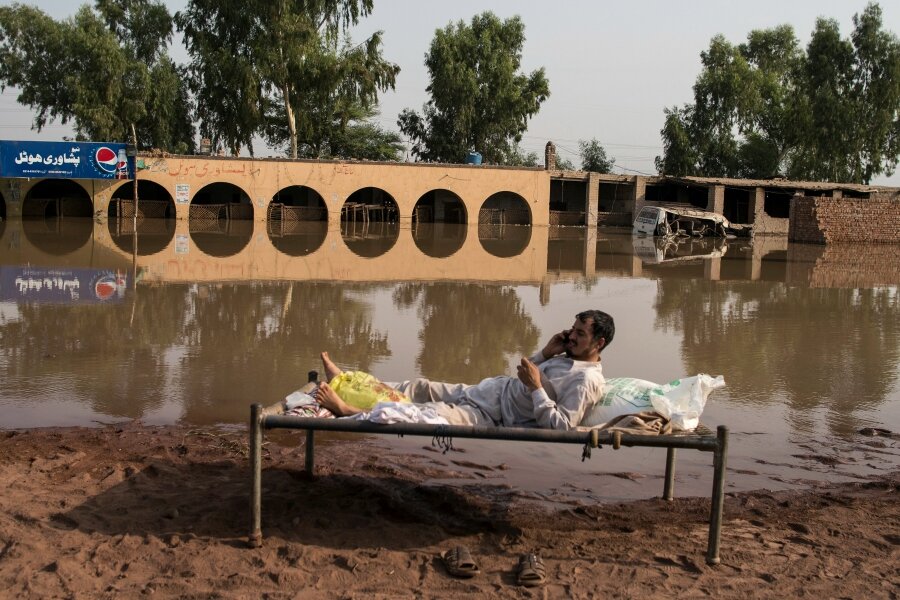Solar network 'in a box' brings phone service to disaster zones
Loading...
| LAHORE, Pakistan
Pakistani researchers have developed a portable, solar-powered mobile phone network for use in disasters like floods and earthquakes when regular communications are often disrupted.
Researchers at the Information Technology University (ITU) in Lahore, Pakistan, together with a team from the University of California, have developed a prototype "Rescue Base Station" (RBS) for Pakistan – the country's first emergency telecom system that would work on normal cell phones.
"When the RBS is installed in a disaster-struck area, people automatically start receiving its signals on their mobile phones. They can manually choose it and then call, send messages, and even browse [internet] data free of charge," said Umar Saif, ITU vice chancellor and an adviser to the project.
The RBS is a lightweight, compact rectangular box fitted with an antenna, a signal amplifier, and a battery, which can be carried easily and even dropped by helicopter into hard-to-reach disaster zones. It has a solar panel to charge the battery, to keep it working in places without electric power.
An alternative communications system like this could help save lives when disasters strike by connecting survivors with rescue workers and government officials.
The RBS has yet to be deployed on the ground, but the ITU expects it to be used in the next six to eight months in partnership with the National Disaster Management Authority and a local telecom company.
Saif said the RBS signal can be received within a 3 km (1.9 mile) radius, and people in the area can easily register by sending their name, occupation, age, and blood group to a special number.
"This helps generate an automatic database of people in distress, and eventually helps both the rescue and relief teams and the victims," he said.
Pakistan has 116 million active cellular subscribers out of a total population of 185 million, according to official data.
Potential users of the RBS system can get the information they need in just a few seconds by sending a text message to specific numbers appearing on their mobile phone.
For example, if a person needs to contact a fire brigade, they text the words "occupation: firefighters" to the relevant number. They will then receive names and contact details for local firefighters in just a few seconds and can call for help, Saif said.
Or if someone needs access to blood supplies, they send a message saying "blood group, B positive," for instance, and receive contact information for people nearby with that blood group, so they can ask for a donation.
Saif said RBS teams on the ground plan to collect information about disaster-affected people in a database and pass this on to rescue teams, doctors, and government departments that can provide assistance.
"[They] can also send weather forecasts and disaster alerts to subscribers, and help them evacuate troubled areas," said Ibrahim Ghaznavi, an ITU researcher and one of the RBS developers.
The RBS, which operates using open source software, offers all the features provided by regular cellphone companies, he added.
Ghaznavi said it costs around $6,000 to develop an RBS, and the Pakistan prototype has been funded by a Google Faculty Research Award.
The RBS team is now working with Endaga, a US-based company that connects rural communities through small-scale independent cellular networks, and a local telecom firm to commercialize the project, he added.
The aim of the collaboration is to help phone companies keep their communications systems functioning in a disaster until their regular networks are restored.
Pakistan is a disaster-prone country, which needs $6 billion to $14 billion to help it adapt to climate change impacts, such as unusually heavy rains, droughts, and melting glaciers, through to 2050, according to a 2011 study funded by the United Nations climate secretariat.
The International Federation of Red Cross and Red Crescent Societies developed a customized communications system called the Trilogy Emergency Response Application (TERA) in Haiti when it was struck by a massive earthquake in 2010.
But that system could only send text messages to its subscribers on their mobile phones, unlike the RBS, which allows users to call, send texts, and even browse the web for free.
Cutting-edge technologies like the RBS could help save more lives by delivering timely advice to disaster-hit people, said Pervaiz Amir, country director for the Pakistan Water Partnership.
"Local researchers should be encouraged to develop innovative solutions to help people in distress," he said. But the RBS needs to be tested in the field under different conditions before being deployed on a wider scale in actual disaster zones, he added.
Amir said the RBS could be useful for rescue and aid activities, especially in remote rural areas of Pakistan where natural disasters regularly disrupt the poor communications systems.
• Reporting by Aamir Saeed; editing by Megan Rowling. This story originally appeared on the website of the Thomson Reuters Foundation, the charitable arm of Thomson Reuters that covers humanitarian news, women's rights, trafficking, corruption, and climate change. Visit www.trust.org.







